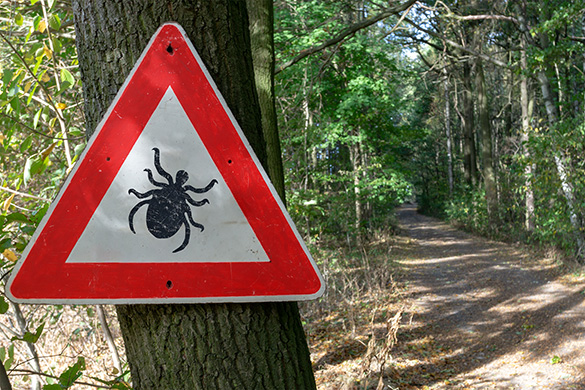Lyme Disease from Tick Bites Can Wreck Summer Fun

The Midwest has many great places to explore, but it’s important to be aware of local risks. One of the big ones we can overlook is ticks. Tick-borne diseases are on the rise, and we all need to take precautions to prevent them. There are many ticks – and they can pose many threats. A better understanding of what’s out there can help us stay outdoors – and stay healthy.
Deer and Lone Star Among Types of Ticks
All ticks carry disease and transmit bacteria after biting, but there are three species responsible for most disease. They include:
American dog tick
Here in the Midwest, we can come across all three, but the American dog tick is most prevalent, and it can carry the bacteria that causes Rocky Mountain spotted fever. Lone-star ticks can also cause spread Rocky Mountain spotted fever, while the deer tick and black-legged tick are most associated with Lyme disease.
Lyme Disease One of Many Tick Threats
There are many diseases associated with the bites of ticks. When unattached, these bugs are unpleasant, but when they bite, they can lead to illnesses including:
- Rocky Mountain spotted fever: This condition can be deadly when not treated with antibiotics right away. It will make you feel headachy and have a rash, and it also creates spikes in temperature.
- Lyme disease: Fever and fatigue, along with headache and rash, are all symptoms of this condition. Treated early with the right antibiotics, people usually recover completely. That’s why tick-checks and prevention is important methods to stop it.
- Other conditions: A wide range of other bacteria can travel from the mouth parts of ticks to your bloodstream.
A number are rare but serious. Always clean any tick bite carefully and if you have any worries about a rash or bite, see your family’s provider.
How to Prevent and Remove Ticks
Prevention of tick bites is the best way to stop infectious diseases. Protect yourself with insect repellent products that contain DEET that have a concentration of at least 20%. Products with 24% concentration or higher can provide protection up to five hours.
When applying repellents, only do so on exposed skin surfaces. Additional layers of protection can include wearing long pants and light-weight shirts with long sleeves. Lighter colors are best.
It’s important to apply repellent with care:
- Don’t put it on your face.
- Avoid cuts or irritations your skin when you use it.
- Mom and dad should help kids apply any insect-stopping product, especially with younger kids who might put their fingers in their mouths.
- Apply it outdoors, to avoid the spray spreading onto interior surfaces or food.
Make sure to wash your hands after you apply.
Removing Ticks Safely
When time outside is done, make sure you check yourself and your children head-to-toe. One easy step you can use is your dryer. Have kids change clothes when they come in, and then throw the outside-worn items into the dryer on high for about 10 minutes.
It’ll remove – and kill – any crawling bugs on the clothes.
If – more likely, when – you find a tick attached to the skin, do not panic. They’re gross, but you need to remove them right away.
It’s best to use tweezers and grasp the tick as close to the skin as possible. Then pull straight away from the skin, and do not twist. This should remove the bug, and allow you to dispose of it, preferably by washing it down the drain. When it’s gone, clean the area near the bite with soap and water, which can help reduce the chance of infection.
Summer is a special time of year, and ticks try to wreck it. Use these tips to stop them and get all the enjoyment out of the season you can.
Natalie Hutton, MD, is a pediatrics specialist with Avera Medical Group Pierre.
Vital Wellness is a series of stories from Avera Medical Group providers who offer insight on sometimes-overlooked aspects of health, wellness and well-being.





